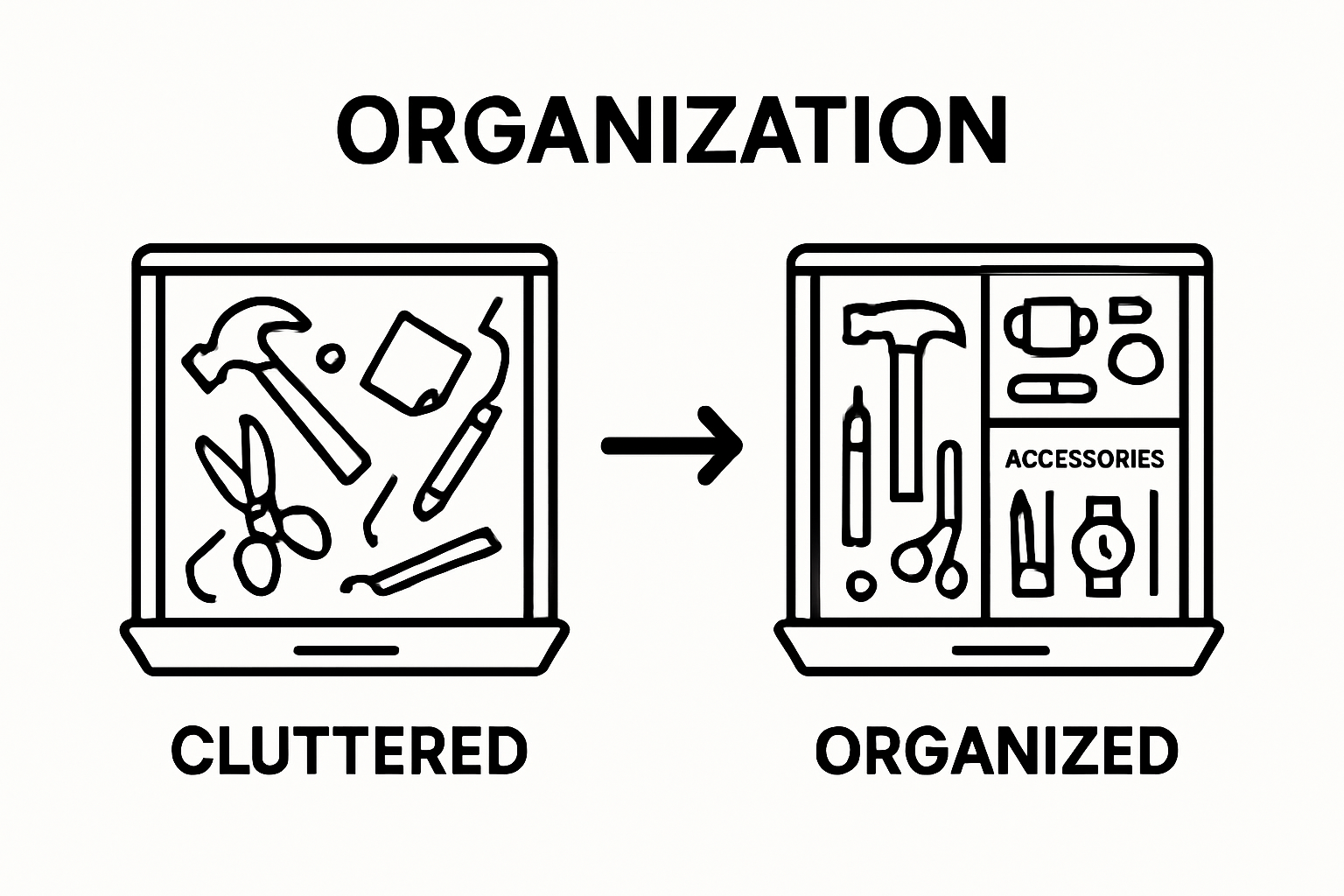
Every home has that secret spot where odd batteries, loose keys, and mystery cables pile up. Studies show nearly 90 percent of Americans admit to having a junk drawer. Most people think these drawers scream disorganization, chaos, and clutter. Actually, they are a life hack hiding in plain sight. The real surprise is just how much smarter your entire home can run when you rethink what belongs in this misunderstood little space.
Table of Contents
- Defining A Junk Drawer And Its Common Contents
- The Importance Of A Junk Drawer In Home Organization
- How A Junk Drawer Functions In Daily Life
- Key Concepts Surrounding Junk Drawers And Their Use
- Tips For Making The Most Of Your Junk Drawer
Quick Summary
| Takeaway | Explanation |
|---|---|
| Junk drawers balance chaos and organization. | They provide flexible storage for items without a home, blending convenience with minimal management. |
| Organized junk drawers reduce decision fatigue. | Designating a space for transitional items minimizes stress and enhances control over clutter. |
| Regular audits keep junk drawers functional. | Periodic checking and sorting help maintain efficiency and prevent accumulation of unnecessary items. |
| Junk drawers reflect personal problem-solving strategies. | The contents reveal insights into a household’s lifestyle and methods for addressing small challenges. |
| Strategic organization transforms junk into utility. | Using dividers and grouping similar items fosters functionality and maximizes drawer space. |
Defining a Junk Drawer and Its Common Contents
A junk drawer is more than just a random storage space in your home. It represents a unique organizational phenomenon where miscellaneous items find temporary refuge when they do not have a designated permanent location. These drawers serve as catch-all spaces that accumulate an eclectic mix of everyday objects, ranging from practical tools to sentimental keepsakes.
The Anatomy of a Typical Junk Drawer
Consumer psychologist Kit Yarrow suggests that junk drawers are complex microcosms of personal organization. Our comprehensive guide on junk drawer organization reveals that these spaces typically contain a diverse array of items:
- Small household tools (scissors, screwdrivers, tape measures)
- Writing implements (pens, pencils, markers)
- Personal accessories (paperclips, safety pins, rubber bands)
- Random electronics (spare batteries, charging cables)
- Miscellaneous ephemera (receipts, takeout menus, random keys)
These drawers often become unintentional time capsules, preserving items that might seem insignificant individually but collectively tell a story about daily life and personal habits.
Why Junk Drawers Develop
Junk drawers emerge organically as a practical solution to managing items that do not immediately fit into structured storage systems. Brandon Keepers describes them as spaces that “shelter items without a designated place,” allowing for the gradual accumulation of objects that do not yet warrant their own specific storage location.
The psychology behind junk drawers is fascinating. They represent a compromise between complete organization and functional chaos. Rather than discarding potentially useful items or spending excessive time categorizing every small object, individuals create these flexible storage zones that balance convenience with minimal effort.
Interestingly, the contents of a junk drawer can reveal much about an individual’s lifestyle, priorities, and problem-solving approach. What might appear as clutter to an outsider often represents a personalized system of temporary storage for a household.
The table below summarizes the most common items found in a typical junk drawer and their everyday purposes, helping clarify the organizational function of this unique space.
| Item Type | Example Items | Common Purpose |
|---|---|---|
| Small Household Tools | Scissors, screwdrivers, tape | Quick fixes and minor repairs |
| Writing Implements | Pens, pencils, markers | Note taking, labeling, signing documents |
| Personal Accessories | Paperclips, safety pins, bands | Securing, organizing, or bundling small objects |
| Random Electronics | Spare batteries, charging cables | Powering or charging devices, electronics upkeep |
| Miscellaneous Ephemera | Receipts, menus, random keys | Reference, storage, or backup for daily needs |
The Importance of a Junk Drawer in Home Organization
While often maligned as chaotic spaces, junk drawers play a surprisingly strategic role in home organization. These multifunctional storage zones serve as critical buffers that help maintain overall household efficiency and reduce daily stress. Explore our expert-approved small space storage tips to complement your junk drawer management strategy.
Psychological Benefits of Organized Chaos
Contrary to popular belief, junk drawers are not signs of disorganization but tactical solutions for managing life’s miscellaneous elements. According to Consumer Reports, transforming these spaces from random storage to purposeful utility zones can significantly enhance household functionality.
The psychological advantages of maintaining a well-curated junk drawer include:
- Reducing decision fatigue by providing a designated space for transitional items
- Creating a sense of control over household clutter
- Minimizing time spent searching for small, frequently used objects
- Preventing important items from being accidentally discarded
Strategic Organization and Time Management
Junk drawers function as dynamic organizational tools that adapt to a household’s changing needs. They represent a pragmatic approach to storage that acknowledges the imperfect nature of daily life. By providing a flexible space for items that do not fit neatly into predefined categories, these drawers help maintain overall home organization without requiring constant micromanagement.
Moreover, a well-maintained junk drawer can save significant time.
The following table compares the psychological and practical benefits of maintaining an organized junk drawer, illustrating its dual impact on daily household life.
| Benefit Type | Key Benefit | Description |
|---|---|---|
| Psychological | Reduces decision fatigue | Lessens stress by designating a space for transitional items |
| Psychological | Creates sense of control | Helps manage clutter and fosters household organization |
| Practical | Minimizes search time | Makes it easy to find small, frequently used objects |
| Practical | Prevents loss of important items | Items are less likely to be misplaced or accidentally discarded |
| Psychological | Provides a buffer against perfectionism | Accepts that life is imperfect and allows flexible clutter management |
How a Junk Drawer Functions in Daily Life
Junk drawers operate as dynamic microcosms of household functionality, serving far more complex roles than simple storage spaces. They function as rapid-response systems that enable quick problem-solving and adaptability in everyday living. Check out our guide on organizing drawers for smart home solutions to enhance your organizational strategies.
Adaptive Problem-Solving Mechanism
According to the Smithsonian, junk drawers represent more than random storage—they are cultural artifacts that reflect human ingenuity and resourcefulness. These spaces become impromptu solution centers where households can quickly address unexpected needs without extensive searching or purchasing new items.
Typical scenarios where junk drawers prove instrumental include:
- Emergency home repairs using miscellaneous tools
- Quickly locating batteries for remote controls
- Finding spare keys during time-sensitive moments
- Accessing adhesive materials for quick fixes
- Storing gift wrap, cards, and occasional celebration supplies
Psychological and Practical Significance
Beyond physical utility, junk drawers play a nuanced psychological role in household management. They represent a controlled form of controlled chaos that acknowledges the unpredictable nature of daily life. By providing a designated space for items that do not cleanly fit into traditional organizational systems, these drawers reduce mental clutter and decision fatigue.
Moreover, junk drawers function as personal archives that capture a household’s unique narrative. They preserve ephemeral objects that might seem insignificant individually but collectively tell stories about family experiences, hobbies, and problem-solving approaches. The contents reveal not just what a household owns, but how its members creatively navigate life’s small challenges—transforming what might appear as disorder into a sophisticated, personalized organizational strategy.
Key Concepts Surrounding Junk Drawers and Their Use
Junk drawers represent more than mere storage spaces—they are complex organizational ecosystems that reflect household dynamics and personal problem-solving strategies. Explore our home organization tips for creating efficient living spaces to enhance your understanding of these unique storage solutions.
Theoretical Foundations of Junk Drawer Organization
According to Consumer Psychological Research, junk drawers are sophisticated systems that reveal significant insights into individual and household behavioral patterns. They function as personal archives that capture the nuanced ways people manage complexity and unpredictability in daily life.
Key theoretical principles underlying junk drawer usage include:
- Adaptive problem-solving mechanism
- Temporary storage for transitional objects
- Psychological buffer against overwhelming organizational demands
- Flexible space for miscellaneous item management
- Personalized chaos management strategy
Functional Dynamics and Psychological Significance
Junk drawers operate as microcosms of household resourcefulness, embodying a unique intersection between practical utility and personal narrative. They serve multiple interconnected functions that extend beyond simple item storage. These spaces become repositories of potential, where seemingly random objects retain value through their capacity for unexpected future use.
Moreover, the contents of a junk drawer can be viewed as a form of material autobiography. Each accumulated item represents a moment, a decision, or a potential solution—transforming these drawers from mere storage spaces into dynamic personal archives that capture the evolving story of a household’s experiences, challenges, and creative problem-solving approaches.
Tips for Making the Most of Your Junk Drawer
Transforming a chaotic junk drawer into an efficient organizational hub requires strategic planning and thoughtful management. Learn expert bedroom storage techniques to apply similar principles across your home organization strategy.
Strategic Organization Techniques
According to Consumer Reports, effective junk drawer management begins with understanding the drawer’s purpose and implementing systematic sorting methods. The goal is not complete elimination but creating a functional, purposeful storage space that serves your household’s unique needs.
Key organizational strategies include:

- Utilize small dividers or compartment trays
- Group similar items together
- Regularly audit and remove unnecessary items
- Measure drawer dimensions before purchasing organizational tools
- Consider lightweight, non-mesh containers to prevent item snagging
Maintenance and Periodic Review
A well-managed junk drawer is not a static entity but a dynamic system requiring periodic attention. Think of it as a living organizational space that evolves with your household’s changing needs. This approach transforms the drawer from a random catchall into a strategic resource that adapts to your lifestyle.

Regular maintenance involves more than just occasional cleaning. It requires a mindful approach to what enters the drawer and a commitment to preventing unnecessary accumulation. By treating the junk drawer as a curated collection of potentially useful items rather than a dumping ground, you create a more intentional and functional storage solution that reduces daily stress and enhances household efficiency.
Transform Your Junk Drawer Into a Haven of Organization
Are you tired of digging through your junk drawer just to find what you need? Many people feel frustrated by the clutter and chaos caused by a disorganized space. The article highlighted how junk drawers can become overloaded with miscellaneous items, turning a useful storage spot into a source of daily stress. If you are ready to take back control and experience the benefits of a functional, tidy home, Blushbees is here to help. Visit our Kitchen Storage section for smart dividers, baskets, and containers designed to keep those tricky drawers in order. With the right tools, your junk drawer becomes a smooth-running station for quick fixes and everyday essentials.

Upgrade your organization today by exploring our solutions at Blushbees. Act now and enjoy an effortless way to bring calm to your home. Shop our range for quality storage products that fit your lifestyle, from the drawer to every corner of your space.
Frequently Asked Questions
What is a junk drawer?
A junk drawer is a multipurpose storage space in your home that holds miscellaneous items lacking a dedicated place. It’s a catch-all zone for everyday objects like tools, writing implements, and small electronics.
Why do people have junk drawers?
Junk drawers develop as practical solutions for managing items that do not easily fit into organized storage. They allow individuals to balance convenience and minimal effort, providing a temporary home for various objects.
How can I organize my junk drawer effectively?
To organize your junk drawer, use small dividers or trays to group similar items together, regularly audit its contents, and measure drawer dimensions before purchasing storage tools. This will create a functional storage space tailored to your needs.
What are the psychological benefits of a junk drawer?
An organized junk drawer reduces decision fatigue by providing a designated space for transitional items, helps minimize time spent searching for frequently used objects, and creates a sense of control over household clutter.
Recommended
- Junk Drawer Organization: Create a Clutter-Free Space – BLUSHBEES USA
- 10 Home Organization Tips for a More Tidy and Efficient Living Space – BLUSHBEES USA
- Maximize Space and Declutter with Collapsible Storage Boxes: The Ultim – BLUSHBEES USA
- Closet Organization Tips 2025: Stylish & Easy Solutions – BLUSHBEES USA



